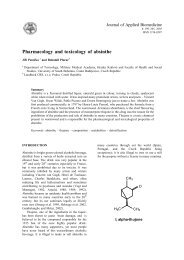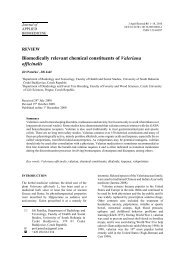Advances in biosensors: principle, architecture and applications
Advances in biosensors: principle, architecture and applications
Advances in biosensors: principle, architecture and applications
Create successful ePaper yourself
Turn your PDF publications into a flip-book with our unique Google optimized e-Paper software.
1<br />
2<br />
3<br />
4<br />
5<br />
6<br />
7<br />
8<br />
9<br />
10<br />
11<br />
12<br />
13<br />
14<br />
15<br />
16<br />
17<br />
18<br />
19<br />
20<br />
21<br />
22<br />
CLASSIFICATION OF BIOSENSOR<br />
Biosensors can be classified either by the type of biological signal<strong>in</strong>g mechanism they utilize<br />
or by the type of signal transduction they employ. Figure 2.0 shows the different categories of<br />
biosensor.<br />
Fig. 2.0. Different categories of biosensor.<br />
BASED ON BIOLOGICAL SIGNAL<br />
The bioreceptor or biological recognition element is the significant dist<strong>in</strong>guish<strong>in</strong>g feature of a<br />
biosensor. The bioreceptor compromises the recognition system of a sensor towards the target<br />
analyte. Essentially it is crucial for a bioreceptor to be selective <strong>and</strong> sensitive towards the<br />
specific target analyte to prevent the <strong>in</strong>terference by other substance from sample matrix<br />
(Lowe 2007). Generally <strong>biosensors</strong> can be classified by the type of biological signal<strong>in</strong>g<br />
mechanism they utilize. The biological signal<strong>in</strong>g used by <strong>biosensors</strong> can be divided <strong>in</strong>to five<br />
major mechanisms (Fig. 3.0). Here, we will discuss each of these mechanisms <strong>in</strong> detail <strong>and</strong><br />
their application:<br />
4





